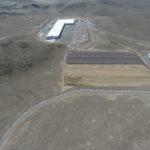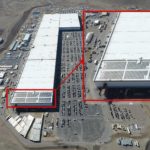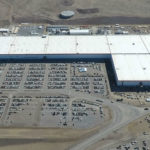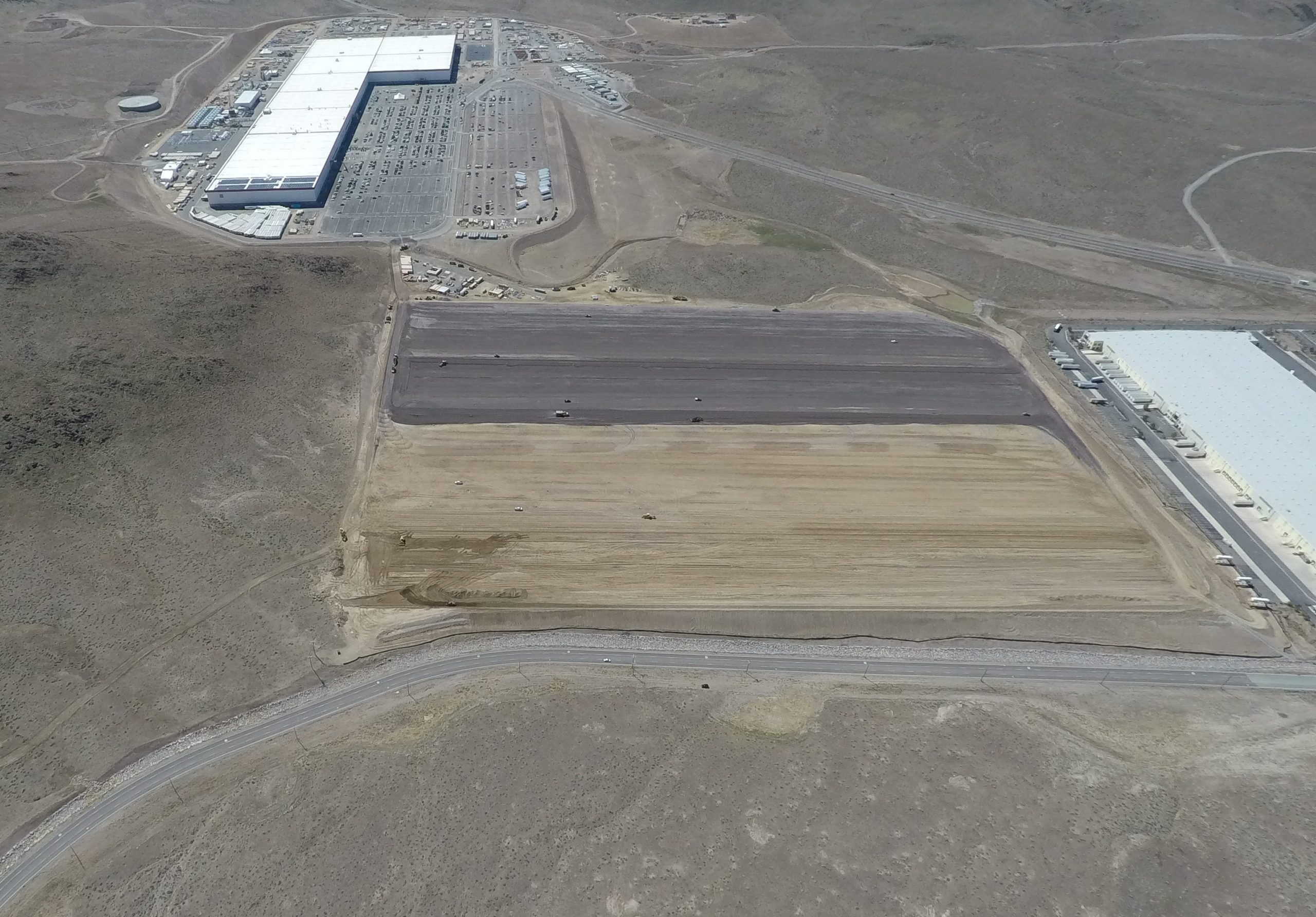
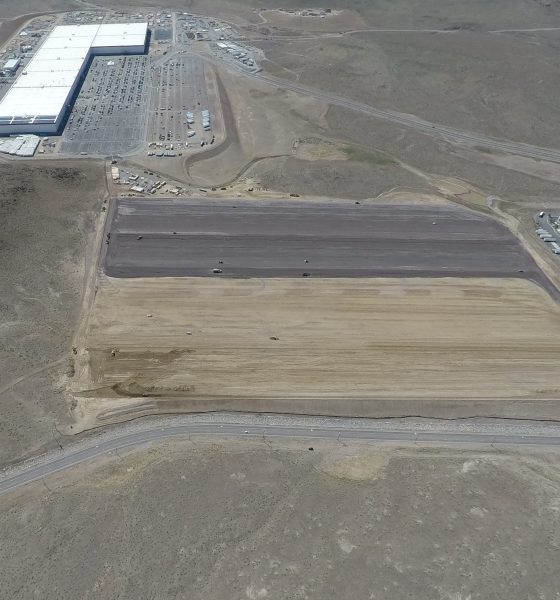
News
Tesla Gigafactory 1 new aerial pictures tease facility’s possible expansion
Recent photographs obtained by Teslarati reveal that Tesla’s new project at the north of Gigafactory 1 is progressing well. As could be seen in the new aerial pictures, a significant portion of the recently-flattened land now appears to be overlaid with asphalt.
Tesla’s recent development in the land north of the Nevada facility was first noticed by Tesla enthusiasts last month. As noted by u/MaChiMiB of the r/TeslaMotors subreddit, the area that Tesla is developing appears to be around 2,000 x 1,500 ft (roughly 600 m x 470 m).
If the aerial photographs we recently acquired are any indication, Tesla seems to have finished moving the dirt and flattening the area, and is now in the process of overlaying asphalt. Overall, the project, which looks like the factory’s new, far more expansive parking lot, will likely be completed in the near future.
- An aerial shot of Tesla’s Gigafactory 1 in NV featuring what appears to be the construction of a new parking lot. [Credit: Teslarati]
- An aerial shot of Tesla’s Gigafactory 1 in NV. [Credit: Teslarati]
- An aerial shot of Tesla’s Gigafactory 1 in NV featuring what appears to be the construction of a new parking lot. [Credit: Teslarati]
Tesla’s development north of Gigafactory 1 bodes well for the company’s plans for the facility. The company, after all, has not increased the building’s physical footprint since last year. Despite the lack of expansion on the building’s exterior, however, reports back in February revealed that Tesla has been upgrading its facilities and equipment within Gigafactory 1.
Over the course of 2017, Tesla filed 112 building permits for the factory, adding another $379.9 million to its investment and raising the total cost of the factory to roughly $1.3 billion. Quite noticeable in Tesla’s building permits in 2017 was the high occurrence of addendums, which correspond to improvements to facilities in the factory that are already built.
From the 112 building permits that were filed by the Elon Musk-led company, 50 were addendums. Permits for new facilities such as a metrology lab, which is designed to ensure that products are manufactured according to precise measurements, were also filed by Tesla in 2017.
- An aerial shot of Gigafactory 1 outside Reno, Nevada, taken during a flyover on March 12, 2018 and showing Tesla’s ongoing construction of a rooftop solar array. [Credit: Teslarati]
- An aerial shot of Gigafactory 1 outside Reno, Nevada, taken during a flyover on March 12, 2018 and showing Tesla’s ongoing construction of a rooftop solar array. [Credit: Teslarati]
- An aerial shot of Tesla’s Gigafactory 1 in NV. [Credit: Teslarati]
Apart from this, Tesla has also begun installing solar panels on the Nevada Gigafactory’s roof. As shown by aerial photographs we acquired last month, Tesla has so far installed six sets of solar panels on the facility. Tesla’s efforts for Gigafactory 1 seem to be teased by the company recently as well, as a leaked email from Elon Musk stated that a hiring ramp would be underway for Gigafactory 1 and Fremont over the next few weeks. The ramp would help the company achieve its aim of producing 6,000 Model 3 a week by the end of the second quarter.
Considering that Tesla is now constructing what appears to be a new parking lot for Gigafactory 1, it seems safe to speculate that the company would soon be expanding the facility’s footprint once more. The factory, after all, might already boast a physical footprint of 1.9 million square feet, but it is still only 30% complete. Once finished, Gigafactory 1 is expected to cover an impressive 13 million square feet. The facility is also expected to boast a production capacity of up to 35 GWh annually.

Elon Musk
Elon Musk and Tesla AI Director share insights after empty driver seat Robotaxi rides
The executives’ unoccupied tests hint at the rapid progress of Tesla’s unsupervised Robotaxi efforts.

Tesla CEO Elon Musk and AI Director Ashok Elluswamy celebrated Christmas Eve by sharing personal experiences with Robotaxi vehicles that had no safety monitor or occupant in the driver’s seat. Musk described the system’s “perfect driving” around Austin, while Elluswamy posted video from the back seat, calling it “an amazing experience.”
The executives’ unoccupied tests hint at the rapid progress of Tesla’s unsupervised Robotaxi efforts.
Elon and Ashok’s firsthand Robotaxi insights
Prior to Musk and the Tesla AI Director’s posts, sightings of unmanned Teslas navigating public roads were widely shared on social media. One such vehicle was spotted in Austin, Texas, which Elon Musk acknowleged by stating that “Testing is underway with no occupants in the car.”
Based on his Christmas Eve post, Musk seemed to have tested an unmanned Tesla himself. “A Tesla with no safety monitor in the car and me sitting in the passenger seat took me all around Austin on Sunday with perfect driving,” Musk wrote in his post.
Elluswamy responded with a 2-minute video showing himself in the rear of an unmanned Tesla. The video featured the vehicle’s empty front seats, as well as its smooth handling through real-world traffic. He captioned his video with the words, “It’s an amazing experience!”
Towards Unsupervised operations
During an xAI Hackathon earlier this month, Elon Musk mentioned that Tesla owed be removing Safety Monitors from its Robotaxis in Austin in just three weeks. “Unsupervised is pretty much solved at this point. So there will be Tesla Robotaxis operating in Austin with no one in them. Not even anyone in the passenger seat in about three weeks,” he said. Musk echoed similar estimates at the 2025 Annual Shareholder Meeting and the Q3 2025 earnings call.
Considering the insights that were posted Musk and Elluswamy, it does appear that Tesla is working hard towards operating its Robotaxis with no safety monitors. This is quite impressive considering that the service was launched just earlier this year.
Elon Musk
Starlink passes 9 million active customers just weeks after hitting 8 million
The milestone highlights the accelerating growth of Starlink, which has now been adding over 20,000 new users per day.

SpaceX’s Starlink satellite internet service has continued its rapid global expansion, surpassing 9 million active customers just weeks after crossing the 8 million mark.
The milestone highlights the accelerating growth of Starlink, which has now been adding over 20,000 new users per day.
9 million customers
In a post on X, SpaceX stated that Starlink now serves over 9 million active users across 155 countries, territories, and markets. The company reached 8 million customers in early November, meaning it added roughly 1 million subscribers in under seven weeks, or about 21,275 new users on average per day.
“Starlink is connecting more than 9M active customers with high-speed internet across 155 countries, territories, and many other markets,” Starlink wrote in a post on its official X account. SpaceX President Gwynne Shotwell also celebrated the milestone on X. “A huge thank you to all of our customers and congrats to the Starlink team for such an incredible product,” she wrote.
That growth rate reflects both rising demand for broadband in underserved regions and Starlink’s expanding satellite constellation, which now includes more than 9,000 low-Earth-orbit satellites designed to deliver high-speed, low-latency internet worldwide.
Starlink’s momentum
Starlink’s momentum has been building up. SpaceX reported 4.6 million Starlink customers in December 2024, followed by 7 million by August 2025, and 8 million customers in November. Independent data also suggests Starlink usage is rising sharply, with Cloudflare reporting that global web traffic from Starlink users more than doubled in 2025, as noted in an Insider report.
Starlink’s momentum is increasingly tied to SpaceX’s broader financial outlook. Elon Musk has said the satellite network is “by far” the company’s largest revenue driver, and reports suggest SpaceX may be positioning itself for an initial public offering as soon as next year, with valuations estimated as high as $1.5 trillion. Musk has also suggested in the past that Starlink could have its own IPO in the future.
News
NVIDIA Director of Robotics: Tesla FSD v14 is the first AI to pass the “Physical Turing Test”
After testing FSD v14, Fan stated that his experience with FSD felt magical at first, but it soon started to feel like a routine.

NVIDIA Director of Robotics Jim Fan has praised Tesla’s Full Self-Driving (Supervised) v14 as the first AI to pass what he described as a “Physical Turing Test.”
After testing FSD v14, Fan stated that his experience with FSD felt magical at first, but it soon started to feel like a routine. And just like smartphones today, removing it now would “actively hurt.”
Jim Fan’s hands-on FSD v14 impressions
Fan, a leading researcher in embodied AI who is currently solving Physical AI at NVIDIA and spearheading the company’s Project GR00T initiative, noted that he actually was late to the Tesla game. He was, however, one of the first to try out FSD v14.
“I was very late to own a Tesla but among the earliest to try out FSD v14. It’s perhaps the first time I experience an AI that passes the Physical Turing Test: after a long day at work, you press a button, lay back, and couldn’t tell if a neural net or a human drove you home,” Fan wrote in a post on X.
Fan added: “Despite knowing exactly how robot learning works, I still find it magical watching the steering wheel turn by itself. First it feels surreal, next it becomes routine. Then, like the smartphone, taking it away actively hurts. This is how humanity gets rewired and glued to god-like technologies.”
The Physical Turing Test
The original Turing Test was conceived by Alan Turing in 1950, and it was aimed at determining if a machine could exhibit behavior that is equivalent to or indistinguishable from a human. By focusing on text-based conversations, the original Turing Test set a high bar for natural language processing and machine learning.
This test has been passed by today’s large language models. However, the capability to converse in a humanlike manner is a completely different challenge from performing real-world problem-solving or physical interactions. Thus, Fan introduced the Physical Turing Test, which challenges AI systems to demonstrate intelligence through physical actions.
Based on Fan’s comments, Tesla has demonstrated these intelligent physical actions with FSD v14. Elon Musk agreed with the NVIDIA executive, stating in a post on X that with FSD v14, “you can sense the sentience maturing.” Musk also praised Tesla AI, calling it the best “real-world AI” today.


